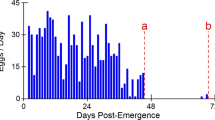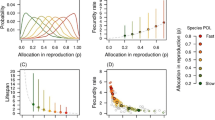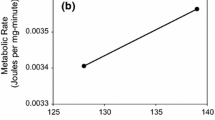Abstract
There is now a significant body of research that establishes the deceleration of mortality rates in late life and their ultimate leveling off on a late-life plateau. Natural selection has been offered as one mechanism responsible for these plateaus. The force of natural selection should also exert such effects on female fecundity. We have already developed a model of female fecundity in late life that incorporates the general predictions of the evolutionary model. The original evolutionary model predicts a decline in fecundity from a peak in early life, followed by a plateau with non-zero fecundity in late life. However, in Drosophila there is also a well-defined decline in fecundity among dying flies, here called the “death spiral”. This effect produces heterogeneity between dying and non-dying flies. Here a hybrid evolutionary heterogeneity model is developed to accommodate both the evolutionary plateau prediction and the death spiral. It is shown that this evolutionary heterogeneity model gives a much better fit to late-life fecundity data.





Similar content being viewed by others
References
Abrams PA, Ludwig D (1995) Optimality theory, Gompertz’ Law, and the disposable-soma theory of senescence. Evolution 49:1055–1066
Beard RE (1959) Note on some mathematical mortality models. In: Wolstenholme GEW, O’Connor M (eds), The lifespan of animals. Ciba foundation colloquium on ageing. Little, Brown, Boston, 302–311
Carey JR (2003) Longevity: the biology and demography of life span. Princeton University Press, Princeton
Carey JR, Curtsinger JW, Vaupel JW (1993) Fruit fly aging and mortality. Response to letters to the editor. Science 260:1567–1569
Carey JR, Liedo P, Orozco D, Vaupel JW (1992) Slowing of mortality rates at older ages in large medfly cohorts. Science 258:457–461
Charlesworth B (2001) Patterns of age-specific means and genetic variances of morality rates predicted by the mutation-accumulation theory of ageing. J Theor Biol 210:47–65
Chippindale AK, Leroi AM, Kim SB, Rose MR (1993) Phenotypic plasticity and selection in Drosophila life-history evolution. I. Nutrition and the cost of reproduction. J Evol Biol 6:171–193
Chippindale AK, Alipaz JA, Chen HW, Rose MR (1997) Experimental evolution of accelerated development in Drosophila. 1. Larval development speed and survival. Evolution 51:1536–1551
Chippindale AK, Ngo AL, Rose MR (2003) The devil in the details of life history evolution: instability and reversal of genetic correlations during selection on Drosophila development. J Genet 82:133–145
Chippindale AK, Alipaz JA, Rose MR (2004) Experimental evolution in of accelerated development in Drosophila 2. Adult fitness and the fast development syndrome. In: Rose MR, Passananti HB, Matos M (eds.), Methuselah flies: a case study in the evolution of aging. World Scientific Press, Singapore pp. 413–435
Curtsinger JW (1995a) Density and age-specific mortality. Genetica 96:179–182
Curtsinger JW (1995b) Density, mortality, and the narrow view. Genetica 96:187–189
Curtsinger JW, Fukui HH, Townsend DR, Vaupel JW (1992) Demography of genotypes: failure of the limited life span paradigm in Drosophila melanogaster. Science 258:461–463
Drapeau MD, Gass EK, Simison MD, Mueller LD, Rose MR (2000) Testing the heterogeneity theory of late-life mortality plateaus by using cohorts of Drosophila melanogaster. Exp. Gerontol 35:71–84
Finch CE (1990) Longevity, senescence, and the genome. The University of Chicago Press, Chicago
Fishman GS (1996) Monte Carlo concepts, algorithms, and applications. Springer, Berlin Heidelberg New York
Graves JL Jr, Mueller LD (1993) Population density effects on longevity. Genetica 91:99–109
Graves JL Jr, Mueller LD (1995) Population density effects on longevity revisited. Genetica 96:183–186
Hamilton WD (1966) The moulding of senescence by natural selection. J Theor Biol 12:12–45
Ives PT (1970) Further genetic studies of the South Amherst population of Drosophila melanogaster. Evolution 24:507–518
Khazaeli AA, Xiu L, Curtsinger JW (1995) Effect of adult cohort density on age-specific mortality in Drosophila melanogaster. J Gerontol Ser A Biol Sci Med Sci 50:262–269
Khazaeli AA, Xiu L, Curtsinger JW (1996) Effect of density on age-specific mortality in Drosophila: a density supplementation experiment. Genetica 98:21–31
Khazaeli AA, Pletcher SD, Curtsinger JW (1998) The fractionation experiment: reducing heterogeneity to investigate age-specific mortality in Drosophila. Mech Ageing Dev 105:301–317
Mueller LD, Drapeau MD, Adams CS, Hammerle CW, Doyal KM, Jazayeri AJ, Ly T, Beguwala SA, Mamidi AR, Rose MR (2003) Statistical tests of demographic heterogeneity theories. Exp Gerontol 38:373–386
Mueller LD, Rose MR (1996) Evolutionary theory predicts late-life mortality plateaus. Proc Natl Acad Sci USA 93:15249–15253
Müller HG, Carey JR, Wu D, Liedo P, Vaupel JW (2001) Reproductive potential predicts longevity of female Mediterranean fruitflies. Proc R Soc Lond Biol Sci 268:445–450
Nusbaum TJ, Graves JL, Mueller LD, Rose MR (1993) Fruit fly aging and mortality (Letter). Science 260:1567
Pletcher SD, Curtsinger JW (1998) Mortality plateaus and the evolution of senescence: why are old-age mortality rates so low? Evolution 52:454–464
Promislow DEL, Tatar M, Pletcher S, Carey JR (1999) Below-threshold mortality: implications for studies in evolution, ecology, and demography. J Evol Biol 12:314–328
Rauser CL, Mueller LD, Rose MR (2003) Aging, fertility, and immortality. Exp Gerontol 38:27–33
Rauser CL, Abdel-Aal Y, Shieh JA, Suen CW, Mueller LD, Rose MR (2005a) Lifelong heterogeneity in fecundity is insufficient to explain late-life fecundity plateaus in Drosophila melanogaster. Exp Gerontol 40:660–670
Rauser CL, Hong JS, Cung MB, Pham KM, Mueller LD, Rose MR (2005b) Testing whether male age or high nutrition causes the cessation of reproductive aging in female Drosophila melanogaster populations. J Rejuvenation Res 8:86–95
Rauser CL, Mueller LD, Rose MR (2006a) The evolution of late life. Ageing Res Rev 5:14–32
Rauser CL, Tierney JJ, Gunion SM, Covarrubias GM, Mueller LD, Rose MR. (2006b) Evolution of late-life fecundity in Drosophila melanogaster. J Evol Bio 19:289–301
Rose MR (1984) Laboratory evolution of postponed senescence in Drosophila melanogaster. Evolution 38:1004–1010
Rose MR, Passananti HB, Matos M (2004) Methuselah flies: a case study in the evolution of aging. World Scientific Press, Singapore
Rose MR, Vu LN, Park SU, Graves JL Jr (1992) Selection on stress resistance increases longevity in Drosophila melanogaster. Exp Gerontol 27:241–250
Rose MR, Drapeau MD, Yazdi PG, Shah KH, Moise DB, Thakar RR, Rauser CL, Mueller LD (2002) Evolution of late-life mortality in Drosophila melanogaster. Evolution 56:1982–1991
Service PM (2000) Heterogeneity in individual mortality risk and its importance for evolutionary studies of senescence. Am Nat 156:1–13
Steinsaltz D (2005) Re-evaluating a test of the heterogeneity explanation for mortality plateaus. Exp Gerontol 40:101–113
Tatar M, Carey JR, Vaupel JW (1993) Long-term cost of reproduction with and without accelerated senescence in Callosobruchus maculates: analysis of age-specific mortality. Evolution 47:1302–1312
Vaupel JW, Carey JR, Christensen K, Johnson TE, Yashin AI, Holm NV, Iachine IA, Kannisto V, Khazaeli AA, Liedo P, Longo VD, Zeng Y, Manton KG, Curtsinger JW (1998) Biodemographic trajectories of longevity. Science 280:855–860
Vaupel JW, Manton KG, Stallard E (1979) The impact of heterogeneity in individual frailty on the dynamics of mortality. Demography 16:439–454
Wachter KW (1999) Evolutionary demographic models for mortality plateaus. Proc Natl Acad Sci USA 96:10544–10547
Zhang Y, Muller HG, Carey JR, Papadopoulos NT (2006) Behavioral trajectories as predictors in event history analysis: male calling behavior forecasts medfly longevity. Mech Ageing Dev 127:680–686
Acknowledgments
We thank the students of the Rose laboratory for assistance with fecundity and survival assays. This research was supported in part by a Sigma Xi GIAR grant to C. L. Rauser and an NSF-DDIG grant to M.R. Rose and C.L. Rauser. C. L. Rauser was supported by GAANN and AAUW Fellowships during portions of this study.
Author information
Authors and Affiliations
Corresponding author
Rights and permissions
About this article
Cite this article
Mueller, L.D., Rauser, C.L. & Rose, M.R. An evolutionary heterogeneity model of late-life fecundity in Drosophila . Biogerontology 8, 147–161 (2007). https://doi.org/10.1007/s10522-006-9042-x
Received:
Accepted:
Published:
Issue Date:
DOI: https://doi.org/10.1007/s10522-006-9042-x




